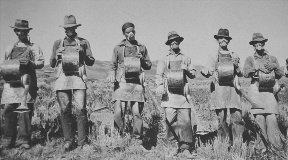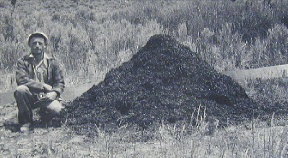HOWARD HICKSON'S
HISTORIES
[Index]
Pesky Little Critters
Crickets in Elko County (1935-1938)
A few oldtimers will remember the cricket
invasion in the 1930s. They tell stories about their car traveling down
a highway, rolling over a cricket army, and having the car slide out of
control for a few seconds of terror.
For four years (1935-1939) those pesky
little critters did a heck of a lot of damage in Elko County. Secret Valley
was where they struck first. Then, in days following, one swarm after another
was reported. Elko, Lander, and Eureka counties were declared disaster
areas. It became very bad before getting better.
Mormon Crickets, of the insect order
Orthoptera, have a number of relatives. They are related to grasshoppers,
Katydids, Mantids, Walkingsticks, the lowly cockroach, and other crickets.
With very short wings, crickets cannot fly, jumping and walking is about
it in their travel repertoire.
If the climate is agreeable - mild winters
and wet springs - millions of them hatch and they're immediately off looking
for food. Tender green things are at the top of their menu. In large armies
they move in one direction. Some masses, one half a mile wide and several
miles long, were reported. As the slew (an old southern expression meaning
at least a jillion) began their quest to denude the landscape, males rush
to the front. In their short life they already know that females will eat
them after mating.
Once on the move, there is no stopping
them. They even tried to invade Elko and Carlin but prompt building of
metal barriers diverted their path. That's how it worked all over Elko
County which bore the brunt of the cricket invasion. There were, basically,
two ways to combat the onslaught - sodium arsenic dust with banana oil
attracted the young ones and metal barriers and ditches were used on all
ages.
 Crickets traveled along the metal barriers
until they reached metal lined pits. Once captured, they are burned and
buried. The poisoned dust did not penetrate the hard shell of the crickets,
but when they cleaned themselves they went to cricket heaven.
Crickets traveled along the metal barriers
until they reached metal lined pits. Once captured, they are burned and
buried. The poisoned dust did not penetrate the hard shell of the crickets,
but when they cleaned themselves they went to cricket heaven.
Men worked long, hot hours, day after
day for several months on the cricket gangs trying to control the
darned things.Government funds were provided and many gangs were enlisted
to fight the pests. Camps, manned by a dozen or two men, were set up -
at one time during the cricket infestation there were 14 crews working
in Elko County. Ranchers sometimes provided beef for a camp, especially
if the men were trying to rid their ranch of the critters. Most camps,
if possible, were set up near streams. A cook and his assistant provided
meals, took care of the camp, and heated water for bathing. They bathed
twice a day. Poison dust, if left on the skin, caused open sores.
It was not an easy job. Most times they
dusted crickets with poison in the morning and went out in the afternoon
to man the barriers and burn the little trouble makers. There are photographs
the Northeastern Nevada Museum showing huge piles of dead crickets. Normally,
the cricket season lasted from the first of April until the end of September.
Airplane dusting later replaced some of the workers. The battle seemed
never ending.
A rancher the Fort Halleck area
reported that 160 acres of his land were covered with the creatures. More
were found on the Evans Ranch near North Fork, at White Rock (near
Wilson Reservoir), the Hunter-Banks outfit west of Elko, and
in the Lamoille area.
 Workers at a camp near Silver Creek awoke
one morning to find crickets everywhere - on their cots, tents, and clothes.
Another worker drank way too much booze one evening and fell asleep on
the ground near his camp. He was lucky that his buddies found him. He was
covered with insects. Miners were forced out of mines. Some say that the
only good that came from the invasion was that crickets ate rattlesnakes,
even going into the snake's burrow to find a tasty meal. One oldtimer remembers
when the insects ate wild onions and then were burned. The obnoxious stench
could be detected a mile away.
Workers at a camp near Silver Creek awoke
one morning to find crickets everywhere - on their cots, tents, and clothes.
Another worker drank way too much booze one evening and fell asleep on
the ground near his camp. He was lucky that his buddies found him. He was
covered with insects. Miners were forced out of mines. Some say that the
only good that came from the invasion was that crickets ate rattlesnakes,
even going into the snake's burrow to find a tasty meal. One oldtimer remembers
when the insects ate wild onions and then were burned. The obnoxious stench
could be detected a mile away.
For four years the crickets chomped
and chomped six months a year but the invasion finally ended. There haven't
been too many serious threats since then but who knows what nature has
in mind for the future?
Howard Hickson
May 7, 2002
Sources: Information for the story came from "Cricket
Gangs" by Tim Pruitt and comments by me in the Northeastern Nevada Historical
Society Quarterly, Summer, 1978 (78-3). Thanks to Tim Pruitt who was
14 when he researched and wrote the article.
Photographs: Courtesy of the Northeastern Nevada Museum,
Elko. Both were taken c.1935.
©Copyright 2002 by Howard Hickson. Permission to
use is given but, if any portion or all of this article is quoted, proper
credit must be given.
[Back to Hickson's
Histories Index]
|

